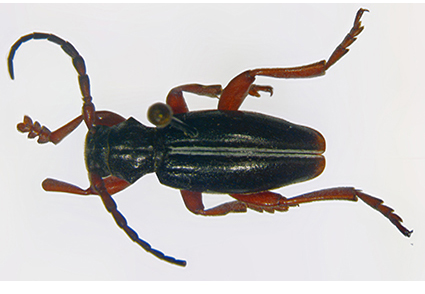Abstract
Due to some biological features, species belonging to genus Dorcadion Dalman, 1817 (Coleoptera: Cerambycidae) can be easily divided into isolated populations. This can be considered as an important factor of speciation process and allows the observation of various effects of biological evolution of taxa. These effects can be measured on morphological characters with some different approaches such as geometric morphometrics. This study aims to determine pronotum and elytra shape differences of the samples of three isolated localities of Turkey (Akyurt, Bala, and Beynam) detected in Ankara, and to contribute to taxonomic and evolutionary knowledge of Dorcadion micans Thomson (1867) by evaluating the analysis of outcomes. As a result, significant differences between populations were detected both in pronotum and elytra. Besides, common variations were observed in some morphological characters of the Bala and Beynam populations, unlike Akyurt population. Accordingly, the distinguishing characters are discussed, and the following new subspecies is described: Dorcadion micans majoripunctum ssp. nov. from Ankara province in Northern part of Central Anatolia.
References
Alibert, P., Moureau, B., Dommergues, J.L. & David, B. (2001) Differentiation at a microgeographical scale within two species of ground beetle, Carabus auronitens and C. nemoralis (Coleoptera: Carabidae): A geometrical morphometric approach. Zoologica Scripta, 30 (4), 299‒311. https://doi.org/10.1046/j.1463-6409.2001.00068.x
Arribas, P., Andujar, C., Sanchez-Fernandez, D., Abellan, P. & Millan, A. (2012) Integrative taxonomy and conservation of cryptic beetles in the Mediterranean region (Hydrophilidae). Zoologica Scripta, 42 (2), 182‒200. https://doi.org/10.1111/zsc.12000
Baur, B., Zschokke, S., Coray, A., Schläpfer, M. & Erhardt, A. (2002) Habitat characteristics of the endangered flightless beetle Dorcadion fuliginator (Coleoptera: Cerambycidae): implications for conservation. Biological Conservation, 105, 133–142. https://doi.org/10.1016/S0006-3207(01)00117‒3
Baur, B., Coray, A., Minoretti, N. & Zschokke, S. (2005) Dispersal of the endangered flightless beetle Dorcadion fuliginator (Coleoptera: Cerambycidae) in spatially realistic landscapes. Biological Conservation, 4, 9‒61. https://doi.org/10.1016/j.biocon.2004.12.011
Bookstein, F.L. (1996) Combining the Tools of Geometric Morphometrics Advances. In: Marcus, L.F., Corti, M., Loy, A., Naylor, G.J.P., Slice, D.E. (Eds.), Morphometrics Plenum Press, New York, pp. 131–152. https://doi.org/10.1007/978-1-4757-9083-2_12
Cabej, N.R. (2012) Epigenetic principles of evolution. Elsevier, London, 852 pp. https://doi.org/10.1016/B978-0-12-415831-3.00003-3
Daniel, K. (1900) Vorläufige Diagnosen. Societas Entomologica, 15, 139‒140.
Danilevsky, M. (2017) Several taxonomic notes on new descriptions of Turkish Dorcadion (Coleoptera, Cerambycidae). Humanity space. International almanac, 6 (1), 33‒37.
Danilevsky, M.L. (2019) Catalogue of Palaearctic Cerambycoidea. Available from: http://www.cerambycidae.net/catalog.pdf (accessed 21 February 2021)
Dapporto, L. (2008) Geometric morphometrics reveal male genitalia differences in the Lasiommata megera/paramegaera complex (Lepidoptera, Nymphalidae) and the lack of a predicted hybridization area in the Tuscan Archipelago, Journal of Zoological Systematic and Evolutionary Research, 46 (3), 224‒230. https://doi.org/10.1111/j.1439-0469.2007.00453.x
Dascalu, M.M. & Fusu, L. (2012) Dorcadion axillare Küster, 1847 (Coleoptera, Cerambycidae): Distribution, morphometrics, karyotype and description of a new subspecies from Romania. Zootaxa, 3322 (1), 35–48. https://doi.org/10.11646/zootaxa.3322.1.2
Doğan Sarıkaya, A., Okutaner, A.Y. & Sarıkaya, Ö. (2019) Geometric morphometric analysis of pronotum shape in two isolated populations of Dorcadion anatolicum Pic, 1900 (Coleoptera: Cerambycidae) in Turkey. Turkish Journal of Entomology, 43 (3), 263–270. https://doi.org/10.16970/entoted.525860
Fusco, G. & Minelli, A. (2010) Phenotypic plasticity in development and evolution: facts and concepts. Philosophical transactions of the Royal Society of London. Series B, Biological Sciences, 365 (1540), 547–556. https://doi.org/10.1098/rstb.2009.0267
Hanski, I.A. (1998) Metapopulation dynamics. Nature, 396, 41–49. https://doi.org/10.1038/23876
Hammer, Ø., Harper, D.A.T. & Ryan, P.D. (2001) PAST: Paleontological statistics software package for education and data analysis. Palaeontologia Electronica, 4, 1–9. Available from: http://palaeo-electronica.org/2001_1/past/issue1_01.htm (accessed 30 June 2021)
Juache, A., Ordenes, R. & Benitez, H.A. (2018) Quantifying the shape variation of the elytra in Patagonian populations of the ground beetle Ceroglossus chilensis (Coleoptera:Carabidae). Zoologischer Anzeiger, 274, 123–126. https://doi.org/10.1016/j.jcz.2018.02.002
Lamb, T., Pollard, R. & Bond, J. (2013) Genetic variation corroborates subspecific delimitation in the Namib fog-basking beetle, Onymacris unguicularis (Haag) (Tenebrionidae: Coleoptera). ZooKeys, 353, 47–60. https://doi.org/10.3897/zookeys.353.6228.
Lazarev, M. (2016) New data on Longicorn-beetles of the genus Dorcadion Dalman, 1817 (Coleoptera: Cerambycidae) from Turkey with descriptions of 3 new species and 4 new subspecies. Humanity space International almanac, 5 (2), 204–229.
Klingenberg, C.P. (2011) MorphoJ: an integrated software package for geometric morphometrics, Molecular Ecology Resources, 11, 353–357. https://doi.org/10.1111/j.1755-0998.2010.02924.x.
Kumral, N., Bilgili, A.U. & Açıkgöz, E. (2012) Dorcadion pseudopreissi (Coleoptera: Cerambycidae), a new turf pest in Turkey, the bio-ecology, population fluctuation and damage on different turf species, Turkish Journal of Entomology, 36 (1), 123–133.
Marsteller, S., Adams, D., Collyer, M. & Condon, M. (2009) Six cryptic species on a single species of host plant: Morphometric evidence for possible reproductive character displacement. Ecological Entomology, 34, 66–73. https://doi.org/10.1111/j.1365-2311.2008.01047.x.
Önalp, B. (1990) Systematic researches on Dorcadion Dalman, 1817 species in Turkey (Coleoptera, Cerambycidae: Lamiinae), I. HÜ Eğitim Fakültesi Dergisi, 5, 57–102.
Özdikmen, H. (2010) The Turkish Dorcadiini with zoogeographical remarks (Coleoptera: Cerambycidae: Lamiinae. Munis Entomology and Zoology, 5, 380–498.
Özdikmen, H. (2016) Dorcadionini of Turkey (Coleoptera: Cerambycidae). Journal of Natural History, 50 (37–38), 2399–2475. https://doi.org/10.1080/00222933.2016.1193653
Rohlf, F.J. (1999) Shape statistics: Procrustes superimpositions and tangent spaces, Journal of Classification, 16, 197–223. https://doi.org/10.1007/s003579900054
Rohlf, F.J. (2017) TpsDig. Version 2.17. Availabl from: https://life.bio.sunysb.edu/morph/soft-dataacq.html (accessed 6 April 2020)
Rundle, H.D. & Schluter, D. (2004) Natural Selection and Ecological Speciation in Sticklebacks. In: Dieckmann, U., Doebeli, M., Metz, J.A.J. & Tautz, D. (Eds.), Adaptive Speciation. Cambridge University Press, London, pp. 192–209. https://doi.org/10.1017/CBO9781139342179.011
Strümpher, W., Sole, C., Villet, M. & Scholtz, C. (2016) Allopatric speciation in the flightless Phoberus capensis (Coleoptera: Trogidae) group, with description of two new species. Insect Systematics & Evolution, 47 (2), 149–179. https://doi.org/10.1163/1876312X-47022138
Thomson, J., 1867. Revisionen und Neubeschreibungen von Käfern. Physis Recueil d’Histoire Naturelle, Paris, 170 pp. https://doi.org/10.5962/bhl.title.38189
Trabelsi, M., Maamouri, F., Quignard, J.P., Boussaïd, M. & Faure, E. (2004) Morphometric or morpho-anatomal and genetic investigations highlight allopatric speciation in Western Mediterranean lagoons within the Atherina lagunae species (Teleostei, Atherinidae). Estuarine, Coastal and Shelf Science, 61 (4), 713–723. https://doi.org/10.1016/j.ecss.2004.07.011
Viscosi, V. & Cardini, A. (2011) Leaf morphology, taxonomy and geometric morphometrics: a simplified protocol for beginners, Plos One, 6 (10), 1–20. https://doi.org/10.1371/journal.pone.0025630


